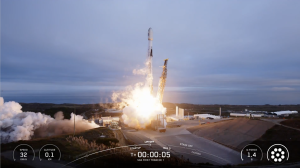After delay, SDA soliciting bids for next batch of global communications satellites

The Pentagon’s Space Development Agency issued a solicitation for the third variant of satellites that aim to give warfighters access to reliable and global communications capabilities.
The request for proposal, published on Sam.gov, is for the Gamma variant of SDA’s Tranche 2 transport layer, of which the organization plans to purchase “approximately 20” space vehicles from a single vendor. The satellites will be part of a larger constellation of 216 systems that “will provide global communications access and deliver persistent regional encrypted connectivity in support of Warfighter missions around the globe,” according to the solicitation.
The Tranche 2 transport layer will be one part of SDA’s Proliferated Warfighter Space Architecture (PWSA), a planned constellation of hundreds of satellites stationed in low-Earth orbit carrying satellite communications, data transport, missile warning and missile-tracking capabilities. The first operational batch of transport satellites in Tranche 1 will provide regional communications, and Tranche 2 will look to expand that coverage across the world.
Overall, the transport layer is considered a key component to realizing Joint All-Domain Command and Control (JADC2) — the Pentagon-wide effort to connect the U.S. military’s sensors and shooters under a more unified network.
The layer will comprise satellites across three different configurations — dubbed Alpha, Beta and Gamma — that have common baseline mission payloads but each offer slightly different capabilities.
Specifically, the Gamma variants will be uniquely equipped with the secretive Warlock mission payload, according to the RFP. While the agency has revealed little about the specific requirements for Warlock, an SDA announcement notes the payloads will be “specifically designed to close future kill chains,” and previous releases indicated that Gamma satellites will provide fire control solutions to warfighters.
The solicitation comes about a week after Congress passed a $825 billion defense spending bill for fiscal 2024, ending a nearly six-month-long continuing resolution. According to a report from Breaking Defense, SDA was forced to delay releasing the solicitation for the Gamma variant until funds for FY ’24 were approved.
Responses to the solicitation are due April 30.
SDA expects to begin launching the first satellites for Tranche 2 in September 2026, and the Gamma satellites are expected to go into orbit by July 2027.
The agency has already awarded contractors for the other two variants in the Tranche 2 tracking layer. In October 2023, Northrop Grumman and York Space Systems were awarded a combined $1.3 billion for the Alpha configurations, of which there will be 100 total satellites.
As for the Beta satellites, Lockheed Martin and Northrop Grumman received $816 million and $733 million, respectively, in August 2023 to each build and deliver 36 space vehicles. Later in January, SDA added Rocket Lab National Security as the third vendor for the Beta variant with a $515 million contract to deliver 18 spacecraft — bringing the total number of Beta satellites to 90.
According to SDA, the agency determined that some of the satellites initially planned for the Gamma variant needed to be shifted over to the Beta configuration as a way to improve tactical satcom capabilities.






